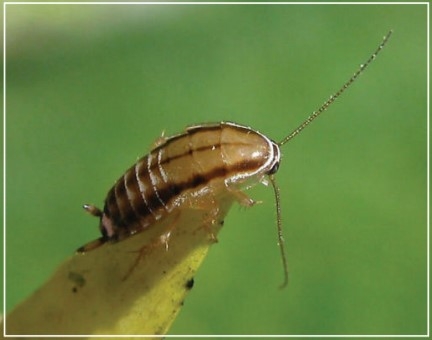Advice for Home Gardeners from the Help Desk of the
UC Master Gardener Program of Contra Costa County
Home Gardener's Request: I found 2 of these little beetle like bugs about 1/4-inch long in our home. Are they cockroaches? I've seen them outside as well.

about 1/4" long
Following is a link to a UC Master Gardener Program Blog from Solano County and below that is an excerpt from the blog that explains the biology and how to manage this new pest. The comments/responses included with the original blog are of interest to as they provide comments from gardeners with this cockroach in their home and garden as well as further comments from a UC entomologist: https://ucanr.edu/blogs/blogcore/postdetail.cfm?postnum=14445
This cockroach is an outdoor species with a penchant for coming inside during drought, flooding, or to overwinter. It should be treated as a nuisance 'invader from outdoors' species, similar to Oriental cockroaches. General guidance to prevent this nuisance cockroach include:
- prevent household invasions by properly sealing cracks and crevices, providing fine mesh screens for open windows, and installing door sweeps (this exclusion process is a bit difficult to accomplish due to the tiny size of this roach, but it should be the goal)
- eliminate suitable habitat near structures by reducing moisture, maintaining structural perimeters (one meter from foundation) free of dense plantings and mulches, and by reducing sources of decomposing organic matter such as woodpiles and compost heaps (especially in close proximity to doors and windows)
- this species serves as a decomposer in the garden and landscape (meaning it feeds on decaying material and typically occurs in leaf litter, plant debris, mulch, and compost piles) and is unlikely to become established within structures. At most, it might be considered a nuisance, as stated above. In many cases, no management actions whatsoever will be necessary against this insect provided you follow the general guidance above.
We hope you find this information helpful for dealing with your new neighbor. Please contact us again if you have more questions.
Help Desk of the UC Master Program of Contra Costa County
Notes: Contra Costa MG's Help Desk is available almost year-round to answer your gardening questions. Except for a few holidays (e.g., last 2 weeks December), we're open every week, Monday through Thursday for walk-ins from 9:00 am to Noon at 2380 Bisso Lane, Concord, CA 94520. We can also be reached via telephone: (925) 608-6683, email: ccmg@ucanr.edu, or on the web at http://ccmg.ucanr.edu/Ask_Us/. MGCC Blogs can be found at http://ccmg.edu/HortCoCo/ You can also subscribe to the Biog.